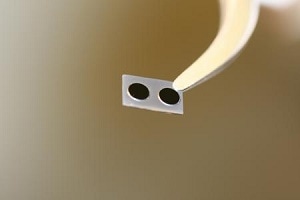Sep 7 2016
 These optical microcavities are where solitons are created. The solitary waves circle around the microscopic disks at the speed of light. (Credit: Qi-Fan Yang/Caltech)
These optical microcavities are where solitons are created. The solitary waves circle around the microscopic disks at the speed of light. (Credit: Qi-Fan Yang/Caltech)
A new type of optical soliton wave has been discovered by a team of applied scientists headed by Caltech's Kerry Vahala. This optical soliton wave travels in the wake of other soliton waves, using the energy of the other wave.
Solitons are localized waves that act like particles: as they move across space, they retain their form and shape rather than spread as other waves do. Scottish engineer John Scott Russell came across these waves in 1834 when he observed an odd wave that formed after the abrupt stop of a barge in the Union Canal between Edinburgh and Falkirk.
Russell tracked the resulting wave for a few miles, and witnessed that it retained its shape as it moved, until he finally lost track of it. He called his sighting a "wave of translation."
Towards the end of the century, the occurrence had been analyzed mathematically, which then produced the concept of the soliton wave.
Under usual conditions, waves are inclined to disperse as they travel across space. To better understand, imagine tossing a stone into a lake, and the ripples will eventually die down as they disperse away from the point of impact; however solitons do not.
In addition to water waves, solitons can transpire as light waves. The team led by Vahala analyzes light solitons by making them recirculate continuously in micrometer-scale circular circuits called optical microcavities.
Solitons can also be used in the development of very accurate optical clocks, and can be applied in microwave oscillators that are used for navigation and radar instruments.
However despite years of research, a soliton is yet to be observed as acting in a dependent - nearly parasitic - manner.
This new soliton rides along with another soliton—essentially, in the other soliton's wake. It also syphons energy off of the other soliton so that it is self-sustaining. It can eventually grow larger than its host.
Kerry Valhala, Caltech
Vahala is the Ted and Ginger Jenkins Professor of Information Science and Technology and Applied Physics and executive officer for applied physics and materials science in the Division of Engineering and Applied Science.
Vahala compares these recently discovered solitons to a carnivorous tropical fish known as pilot fish, which swim close to a shark in order to pick up scraps from the shark's feed. The pilot fish minimizes the drag of water on their own body by swimming in the shark's wake, so they can travel without putting in much effort.
Vahala is the corresponding author of a paper in the Nature Physics journal, which showcases and illustrates the new type of soliton, christened as the "Stokes soliton." Caltech graduate students Qi-Fan Yang and Xu Yi were the first to spot this new soliton.
As the new soliton had the ability to directly match the shape and position of the original soliton, Yang's and Yi's initial reaction to the wave was to suspect that lab instrumentation was faulty.
We confirmed that the signal was not an artifact of the instrumentation by observing the signal on two spectrometers. We then knew it was real and had to figure out why a new soliton would spontaneously appear like this.
Qi-Fan Yang, Graduate Student, Caltech
The microcavities that Vahala and his team use comprise of a laser input that provides the energy for the solitons. This energy cannot be immediately absorbed by the Stokes soliton - the "pilot fish." Instead, the energy is absorbed by the "shark" soliton. Vahala and his team discovered that the energy is then drawn away by the pilot fish soliton, which grows in size while the other soliton diminishes.
"Once we understood the environment required to sustain the new soliton, it actually became possible to design the microcavities to guarantee their formation and even their properties like wavelength—effectively, color," Yi says. Yi and Yang collaborated with graduate student Ki Youl Yang on the research.
This research is illustrated in a paper titled "Stokes solitons in optical microcavities," published on September 5. The research received financially assistance from the Defense Advanced Research Projects Agency under the PULSE Program; NASA; the Kavli Nanoscience Institute; and the Institute for Quantum Information and Matter, a National Science Foundation Physics Frontiers Center supported by the Gordon and Betty Moore Foundation.